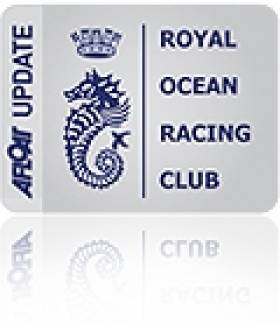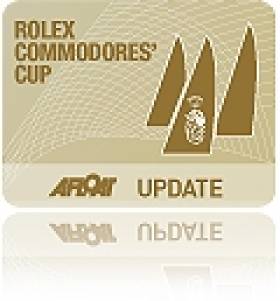Displaying items by tag: Commodores' Cup
France Blue Continues to Lead Commodore's Cup
Despite three more inshore races being held on day five of the Brewin Dolphin Commodores' Cup, the Royal Ocean Racing Club's biennial flagship event for three boat teams with Corinthian crews, France Blue leads with a similar 11.5 point margin to yesterday, but Flanders North Sea is now the team that has relieved France White of second place overall.
Today racing returned to the central-eastern Solent with two windward-leeward races and one round the cans course. The day started in July-like sunshine and a light southwesterly, but the arrival of an occluding front early afternoon brought cloud, light rain and an ultra-shifty breeze and fog thick enough to make spotting marks hard - more October-like conditions.
The first race saw a pair of wins for GBR Red: The Henning family's Mumm 36, Alice, won in Class 1 and the J/35, Bengal Magic, claimed the small boat race - the first bullets for both boats.
For Alice, it was well timed. This was after a recent fight with a pontoon in Cork that required intense repair work only completed last Friday, and followed a grounding on the Hampshire shore yesterday and another long night in the shed.
"It hasn't been great this last couple of weeks," admitted Simon Henning. As to today's race win: "The wind was right for us - nice and light on the first beat. We had a good start and went left, where the tide was better."
The lighter, flatter water first race favoured the 20+ year old designs, Bengal Magic skipper James Chalmers agreed: "The wind was a bit lighter and everything just seemed a lot easier. We had to spin around the back because we were over early, but we knew the direction we wanted to go in and give that a push." They too benefitted from hitting the left.
However GBR Red has 184.5 points, just 4.5 away from the podium, but is struggling for consistency. La Réponse's normally immaculate starting left them today - in all three races they were over early. "The team thing is great," continued Chalmers. "You have good days and you have bad days. In the last race, we went the wrong way up the first beat and paid for it. In this event you get punished for the slightest mistake."
Today's top scoring boat was Noel Racine's JPK 1010 Foggy Dew, the 'small' boat in France White with a 5-1-1. Their team mate, the First 40.7, Pen Koent of Emmanuel le Men, is the top scoring 'big' boat, however their performance is offset by Didier Gaudoux's JND 39, Lann Ael 2, which scored three of today's biggest results. Mention should be made of Andrew Hurst's sistership, Stamina, which had her best day finishing third the two final races.
Race two saw a win for GBR Blue's and the Blair family's King 40, Cobra, but they sandwiched this between an 10th and an 8th. Spokesman and mastman, Richard Moxey, described their winning race: "We nailed the start and the first beat, going left. We made smooth manoeuvres, no muck-ups. Then we hoisted and did a quick gybe and had clear wind for the run."
In the Israeli team, placed fifth overall, it was the turn of the JPK 1010, Carlton, Tel Aviv, to perform best, posting a 2-7-5.
Omer Brand, upwind trimmer and Team Israel manager commented: "All in all, I think we are doing well for our first attempt bearing in mind that most of the guys [and girls] have never sailed on these types of boats nor done a serious regatta before. They are loving it and are never giving up."
Once again France Blue was the star performer, but even they are having a mixed set of results, as yacht designer Daniel Andrieu, skipper of their 'small' boat, Cifraline 4, explained: "Yesterday we had a very, very poor day with bad starts, laylines and spinnaker sets - everything was bad. Yesterday night we had a big meeting - we didn't change anything, but we decided how to improve everything. This morning we went out early and did a lot of manoeuvres with spinnakers, gybes, tacks, laylines, etc and after that we were better prepared."
Cifraline's seven crew, five of whom, Andrieu admits, are closer to 70 than 60 years old, also preferred being back in the central eastern Solent, even though conditions were still tricky. "The wind is more shifty. You get a lake of wind and then a shift of 20°. It is great fun!"
Racing continues tomorrow with the traditional race around the Isle of Wight which will score with a 1.5x co-efficient.
ICRA Plans 2016 Commodores Cup Defence at Portlaoise Meeting
This week's Irish Cruiser Racer Association (ICRA) meeting in Portlaoise heard a full agenda that included plans for the defence of its Commodore's Cup title. Putting a team together to retain the Cup will be no easy feat especially with this week's news Great Britain intends to send four strong teams to Cowes in July 2016.
So far word from the Kildare meet suggests victorious Royal Cork team Captain Anthony O'Leary will very much be part of the title defence but, as previously reported, the acclaimed shore team of Fintan Cairns and Barry Rose will step down.
Quokka, the UK owned 43–footer that filled the middle slot for Ireland in 2014, appears to be still connected with skipper Michael Boyd but she is also for sale so it is unclear if she will be available next summer.
A small boat is now required for the 2016 team and a JPK 10.80 (a sistership to this year's Fastnet winner) is heading for Dublin Bay next year and although selectors have identified her as a key candidate it does not mean the new owner will necessarily put the boat forward. Afloat.ie understands other options for the small boat are also being considered, including a link up with a UK based JPK 10.80.
Meanwhile, selection is open for the Great Britain team, with the RYA planning to send four teams of three boats to represent Great Britain.
The RYA is seeking expressions of interest from owners and teams who would like to compete for Great Britain at the 2016 event. Teams comprise of three boats within the IRC rating 1.0 - 1.230. One team will be nominated by RYA Scotland and the other three by the RYA.
The seven day event consists of two offshore events within the English Channel and a number of inshore events in the Solent, pitting three-boat teams against one another to win overall team points.
The selection process will begin in the New Year with a number of events defined as selection regattas.
The completed RYA selection Trials Entry Form and proposed crew lists for the Selections Trials of the GBR teams should be delivered to the RYA before 1700 on Friday 29 January, together with the entry fee. Entries after this date will be accepted up to Friday 25 March subject to a late entry fee.
#sailorofthemonth – It has been a busy and successful sailing season for Irish crews at home and abroad, and one team achievement stands head and shoulders above all others in setting the tone for the year.
Ireland's runaway victory in the international and multi-faceted Brewin Dolphin Commodore's Cup series from July 20th to 26th has raised the mood of the nation in a very encouraging way. And while many were involved, there is no doubt that one man, the Team Captain Anthony O'Leary of Cork, was head and shoulders above all others in making the primary contribution.
Part of the robust build-up to Ireland's challenge was the British IRC Championship. As a result of his convincing overall win of that title with his Ker 39 Antix, Anthony O'Leary was Afloat.ie "Sailor of the Month" for June. Thus the adjudicators feel that as O'Leary is already in the pool for the overall award at the end of the year, they are enabled to deploy the monthly award to another meritorious sailor.
But in any case, one of the significant aspects of the Commodore's Cup campaign was the way in which several American and British sailors became involved in this Irish campaign. Of the total sailing squad of 31, four were American while six were British. Yet they were all wearing the green jerseys with full commitment.
To celebrate this, we're making one of our special International Awards. The last one was in 2013 for Bruno Sroka, who kite-surfed from France to Ireland - the ultimate lone achievement. This time round, it couldn't be more different. Ireland's Brewin Dolphin Commodore's Cup victory is surely the ultimate team achievement, but very deserving of the Afloat.ie International Award.
#rorcbdcc – Ireland's convincing international victory in the Brewin Dolphin Commodore's Cup has been the perfect tonic for a sailing community discouraged by economic recession. W M Nixon meets the winning Team Captain and shoots the breeze about how it was done, and what the future might bring
Cool. That's the best word to describe Ireland's remarkable win in the Commodore's Cup a week ago. It was the coolest thing you ever saw, this stylish and clearcut team win, crafted in sailing conditions which were mostly hot and bothersome. And it has provided a mighty boost for a bruised sailing community which, two years ago, was simply unable to mount any defence whatsoever of our first ever Commodore's Cup win 2010. For, in 2012, the Emerald Isle was flat broke.
Things are starting to move again, though ever so slowly. But when we look back on the crazy history of the boom and bust, it may well be that Irish sailors will realise that the upward turning point was this famous win. But in fact, the turning point must have been some little time ago, as it took months of visionary planning with quiet behind-the-scenes effort to put a realistic campaign together.
Yet as the dust settles and the bubbles fade away, there's no doubt that one man is head and shoulders above all others in bringing this about. And he's here, the Main Man, the Irish Team Captain, in the soothing peace of his beloved home club of the Royal Cork at Crosshaven just four days after Ireland was declared winner on the lawns of the Royal Yacht Squadron castle at Cowes.
Forty Irish sailors and their management broke into a mighty rendition of The Fields of Athenry. Noisy stuff and noisy celebrations which reverberated joyously back home. But here in the cool and calm of the friendly clubhouse, with a tasty bar lunch which, it later emerges, is on the house (thank you very much, RCYC), Anthony O'Leary is relaxing and taking a break.
It's a short break not only from the demands of leading the Commodore's Cup campaign, but from the hectic pace of work, for back in the office he finds he's trying to do two months work in a week. That said, "taking a break" is only a relative term with an O'Leary. Planning, organisation, action and achievement are in the family's genes. Even in this hour-and-a-half of just shooting the breeze, more memories, concepts, ideas, suggestions and proposals are aired than you'd get from a waggonload of academics. And they're all pure gold, well weighted with wisdom.
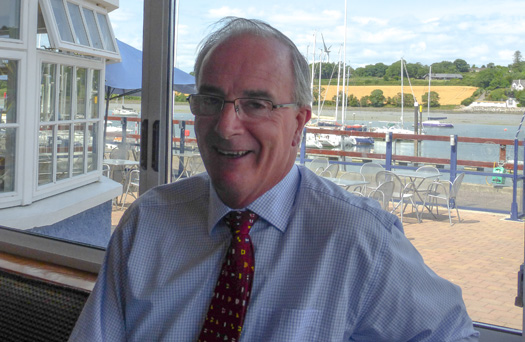
Anthony O'Leary relaxing in the Royal Cork YC four days after winning the Commodore's Cup. Photo: W M Nixon
So who is Anthony O'Leary? Well, he's a Corkman through and through, a 58-year-old sportsman who has not been easy on himself down the years. He took a battering on the rugby field playing for Munster, yet at the same time he was building a formidable sailing career both in his own right and with his characterful father Archie, who got into the offshore racing game in 1971 when Anthony was 15 and already a rising star in Fireball racing at an age when many other youngsters would be still sailing Optimists.
Naturally he shared the Crosshaven enthusiasm for National 18 racing under the tutelage of Somers Payne, but it was keelboat racing inshore and offshore which was to become his true metier. Serious success started in 1974, when the O'Learys raced their new production Carter 37 Irish Mist in the One Ton Worlds at Torquay. That was the year when Gumboots and Golden Apple grabbed the headlines, but Anthony recalls that one of his father's most treasured sailing prizes is the massive Production Boat Trophy. Irish Mist may have placed twelfth overall in a large and stellar fleet, but everything ahead of her was a mega-expensive one-off, yet she was in a class of her own at the front of the production boat division.
They were hooked, and next boat up was the legendary Ron Holland-designed 40ft Two Tonner Irish Mist II, built beside Cork Harbour by George Bushe with his son Killian. Young Anthony was on the build team, and then went afloat with the new and fabulously successful boat to compete in, among other events, the Admirals Cup. It was a steep learning curve. For though Irish Mist II was among the best, not all the Irish team were front line boats. It was an early and lasting lesson in team assembly.
Life in the 1980s became increasing dominated by a serious back injury in rugby which in 1988 saw complex surgery for spinal fusion, with three vertebrae being made into one. Not an experience for the faint-hearted, and he still shows evidence of it in his movement, though it doesn't cramp his style. Inevitably, active sailing was out for a year, but being Anthony O'Leary, he spent the entire season of 1989 making the only contribution he could, on the Royal Cork's Race Officer team. He recalls it as one of his peak learning years, and if he happens to make a comment about someone else's race administration, you know it is being done from a deep well of personal experience.
Marriage came to Sally Aisher of one of the most renowned English sailing families, and their sons' subsequent sailing success at home and abroad is evidence of an extraordinary bloodline. Yet they could be an ordinary sailing family too – he fondly recalls pottering about Cork Harbour in a little clinker-built cruiser called Nerissima which he restored from a very tired state.
However, the wheels of destiny were turning, and with the new Milennium in 2000, he became the youngest-ever Admiral of the Royal Cork, having served his time in many voluntary posts and on several committees during his climb aloft. He quips that the first thing any wannabe Admiral should know is that your members will expect you and your wife to be in the clubhouse greeting them every – but every – Saturday night, and you should be there most other nights too, as well as campaigning a boat of your own in true leadership style.
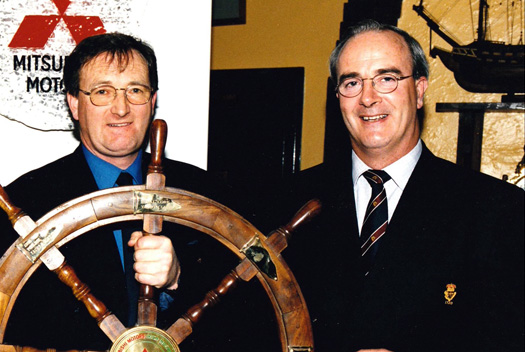
As Admiral of the Royal Cork YC 2000-2002, Anthony O'Leary receives the Mitsubishi Motors Sailing Club of the year award with former Admiral Kevin Lane (left)
It was a memorable two years, the highlight being Royal Cork's staging of the Laser Worlds, still one of the biggest and best dinghy championships ever sailed in Ireland. In typical style, O'Leary is diligent in listing off the top figures in Laser administration in Ireland and worldwide who ensured that it was such a success.
As for his own sailing, we are now into the Antix years. The first Antix was a Corby 35 originally called Converting Machine, and sailed home to Crosshaven one breezy November night from Plymouth in 23 hours with a doughty crew who were to become a key element in the O'Leary family's years of successful campaigning with a much-loved boat. Put simply, Antix was everywhere and won everything. But the inevitable change came with the 2008 Commodore's Cup when Colm Barrington turned up with a crisp new Croatian-built Ker 39 which, in due course, with a certain inevitability, became the new Antix, the boat with which Anthony O'Leary is now most totally associated.
She may be six years old, but Antix is very much work in progess, and in his years of ownership – which got fully under way with the Commodore's Cup win in 2010 – O'Leary has been closely involved in the upgrades and modifications which have kept her at the front of the fleet. In 2010 she was a heavy weather superstar, but to broaden her range, they tried fitting a lighter keel bulb. That didn't quite work, so they went back to the original keel but tweaked the headsail sizes upwards. That resulted in three or four extra notches in the rating, but the boat is now nearly as good as she'll get, yet the work goes on.
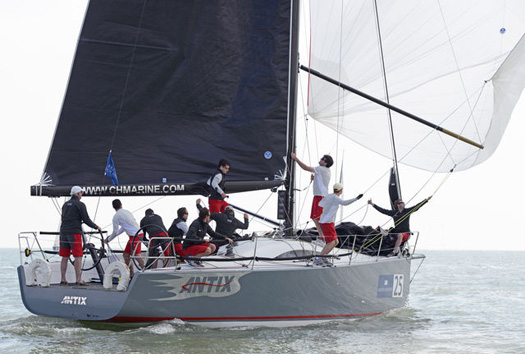
Antix racing in the Brewin Dolphin Commodore's Cup 2014. Although now six years old, with keen sailing, regular updates and fresh tuning she is still competitive, and in the series she secured three wins, two seconds and a third.
With a boat of this calibre, and his own long-proven waterfront cred, Anthony O'Leary has been able to assemble an amateur crew panel of exceptional talent and compatibility. His system was working exceptionally well, so it was a cruel blow when any 2012 defence of the Commodore's Cup was declared a non-runner. But he saw the non-runner declaration as no more than unfinished business, and quietly asserted among friends that Ireland was on a four year defence programme of the Commodore's Cup dating back to 2010, and aiming for fruition in 2014. The hidden wheels were turning slowly, but turning nevertheless and with increasing purpose.
It could be said that if you can't grasp how the entire complex panoply of a modern amateur offshore racing campaign is assembled without being told, then you're never going to catch on anyway. The essence of it all is keeping it low key. Quiet moves behind the scenes. Promising newcomers being marked down as possible future crewmembers. Subtle recruiting among top One Design sailors – you'd be surprised how comfortably they take to "truck racing". Gentle encouragement for those who merit it. Remember always the Holy Grail of compatibility, yet know when to accommodate the Awkward Squad when they have the talent. Steady building on a record of success. Simply having the boat ready and willing when you say you will. Having a realistic yet sufficiently demanding campaign in mind. A quiet sense of team building while cherishing individuality. It all adds up.
That said, it has to be agreed that Ireland is uniquely placed to do well in today's top international amateur sailing events. The reality is that our population is too small and dispersed to support a significant professional sailing squad at home. Thus most of the crews sailing for Ireland in the 2014 Commodore's Cup team are of such a high ability that if their home was in the south of England, or a sailing area of France or the Netherlands, or around Long Island Sound or San Francisco or Sydney Harbour or wherever wealth and population and sailing coincide, then they'd be under great pressure to turn professional. After all, it's the easy option for busy owners with big boats to race. Simply paying someone who is good takes out a lot of hassle and cajoling and squaring of employers, which is the way things are done here.
In Ireland, with the size we are and the way we are, we just don't do paid sailing. So when a major event with amateur emphasis like the Commodore's Cup comes along, we're in with more than a shout, even if it does involve yet more hassle and cajoling and squaring of employers to get some talented amateur sailor an extra day or two off work "to go yachting". But we like having the day job – it makes going sailing more fun.
While keeping the kettle quietly on the boil at home in the recessionary years, Anthony O'Leary continued to play a leading role on the international scene. He rose to become Vice Commodore of the RORC, which gives him a special insight into the workings of what is, in effect, offshore racing's world body. Afloat, he was a regular and successful contender in major offshore race events. His sons meanwhile were cutting a hugely successful swathe through sailing at home and abroad. In all, it was a situation which had him ideally placed to assemble an outline of the personnel suitable for an Irish Commodore's Cup team in 2014.
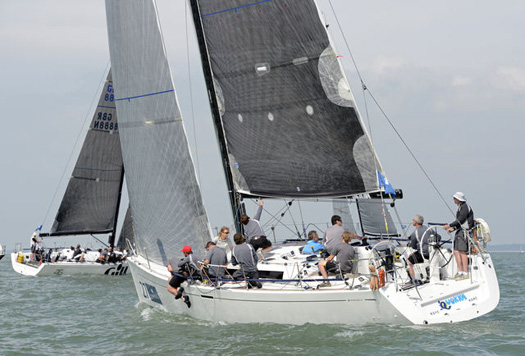
The Grand Soleil 43 Quokka, chartered by Michael Boyd and Niall Dowling of the Royal Irish YC, was an excellent all-rounder whose low rating for her size provided a very useful boost.
Then there was the matter of boats. There was ruthless pursuit of the best possible. Antix was going better than ever. For a second boat, Niall Dowling, of Dun Laoghaire's Royal Irish Yacht Club, but with business interests in England and a sailing pied a terre in Cowes, had been disappointed by the lack of an Irish defence in 2012. So he teamed up with fellow RIYC member Michael Boyd and their search for a boat settled on a charter of the eminently suitable Grand Soleil 43 Quokka 8, a regular and very successful RORC contender in the ownership of Peter Rutter.
The foundations were laid, but any prospect of success would be greatly aided by a new boat of exceptional potential. Thanks to his Olympic sailing son Peter's friendship with American sailor Geoff Ewenson, the younger O'Leary was on the inside track on a new Ker 40 being built for New York art dealer Mark Glimcher. The latest line of Ker 40s marks a considerable advance on Antix, as their flared hulls - which are dish-like at the stern – confer performance benefits which – when they're properly sailed – more than offset a higher rating.

Antix managing to keep ahead of the newer Ker 40 Cutting Edge with her dished stern.
As the winter racing season got under way in Florida early in 2014, Catapult was already cutting the mustard with the big regatta at Key West reinforcing her reputation, and providing Anthony O'Leary with the opportunity to go there and add the Glimcher boat to his team, as his son was in the crew. It boggles the mind, though, to imagine the scene. End of day's racing, everyone salt-stained and sunburnt, young Irish sailor goes up to owner and says: "Mark, this is my dad, he wants you to bring your boat to Europe to race for Ireland in the Commodore's Cup, and he'll organise most of your crew....."
Quite. Whatever technique they employed, it worked. But even so, when life is being lived at the New York pace, you reckon that anything that seems to good to be true usually is. So Anthony now admits that he didn't really believe it was all happening until the fantastic Catapult was unloaded from a ship in Europe. But by that time, his nascent team were having other problems. Quokka was doing the winter season racing in the Caribbean, and Michael Boyd and Niall Dowling had sailed aboard in the Caribbean 600. But then the ship which was due to bring her home in time for the RORC IRC Championships early in the new European season was badly delayed. However, the two Irish co-skippers gallantly chartered another temporary boat to get their crew training under way. Meanwhile Anthony O'Leary kept things nicely up to speed with a runaway overall win with Antix in the British IRC Championship.

The closest challenge to Ireland came from the French teams. Among their boats was former Round Ireland winner Inis Mor, a sister ship of Antix.

Aboard Antix, the Main Man does much of his own helming
The Quokka crew had to charter another stop-gap boat to keep the show on the road. But finally their ship came home, and most appropriately it was Volvo Cork Week from July 6th to 12th when the Irish Commodores Cup Team 2014 of Antix, Catapult and Quokka finally made their proper debut together, and their performance was, to say the least, very encouraging.
But a fun regatta was one thing, the Brewin Dolphin Commodore's Cup with nine teams just one short week later was something else altogether. Ireland gave it her best shot, with the crew lineup (Irish unless otherwise stated) being:
IRL 3939 Antix:
Fred Cudmore, Rosscoe Deasy, Jamie Donegan, David Lenz (UK), Ross McDonald, Derek Moynan, Darragh O'Connor, Robert O'Leary, Anthony O'Leary, Clive O'Shea.
USA 1253 Catapult
David Bolton, Grady Byus (US), Alan Curran, Garth Dennis (US), Geoffrey Ewenson (US), Mark Glimcher (US), Tom Murphy, Dan O'Grady, Peter O'Leary, Ian Travers.
GBR 2215L Quokka 8
James Allan (UK), James Bendon, Michael Boyd, Laura Collister (UK), Ben Daly (UK), Niall Dowling; Jarrod Hulett (UK), Tom Whitburn (UK), Nelson Moore, Maurice O'Connell, Nicholas O'Leary.

France's new A13 Teasing Machine had all the bells and whistles including twin rudders and a full factory shore support team, but Ireland's amateurs stayed ahead of her.
They had the ships, they had the men (and one woman), but where was the wind? A great blocking high sat over England, and even the usually reliable afternoon seabreezes of the Solent were unable to generate. Yet astonishingly, despite the fact that Irish sailors are supposed to prefer a good breeze of wind, they did it, and in very convincing style in races of all shapes and sizes, and in a fleet of 27 boats in which several teams were built on almost unlimited resources.
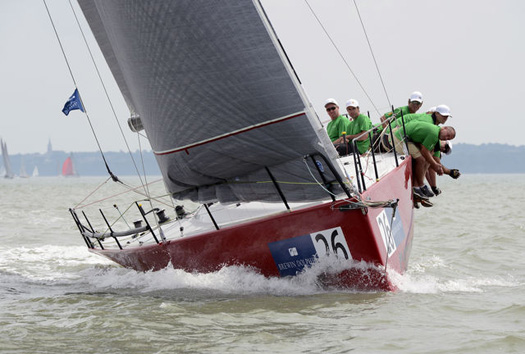
We're the boys in the green jerseys – Catapult took to being Irish like a duck to water
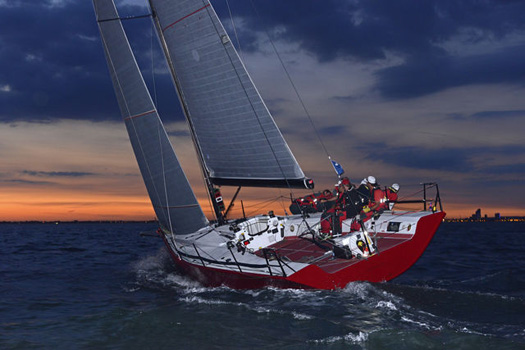
Line honours for Catapult yet again, this time in the overnight offshore race
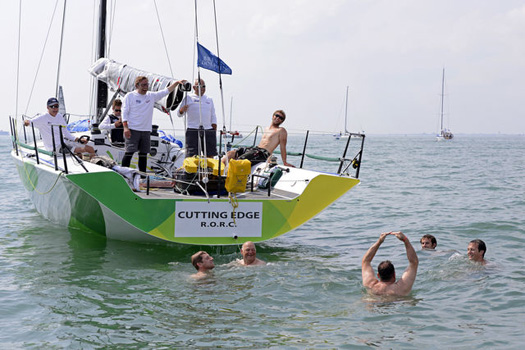
The dished stern on the new breed of Ker 40s with Cutting Edge's crew swimming on the lost day

There was too much of this sort of thing – frustrating conditions for Quokka, Eleuthera and Localletterbox Zero II on the day when no race was completed. Localletterbox was originally Mariners Cove from Ireland.

When the going was good....Antix hanging in there ahead of the newer Cutting Edge........

...and Quokka hanging in very well on Inis Mor's quarter as they come to the mark
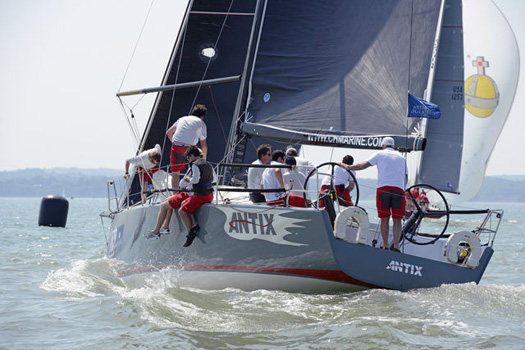 Antix savoring an all-too-rare moment when the Solent came to life
Antix savoring an all-too-rare moment when the Solent came to life
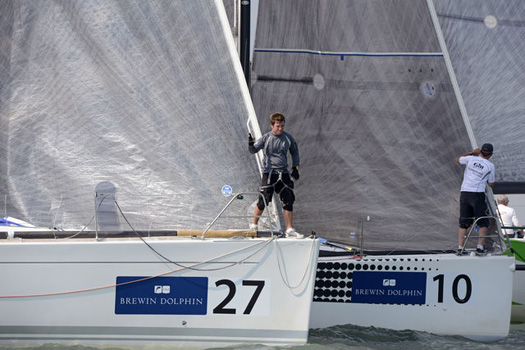
Quokka's bowman James Bendon from Baltimore calls the start
Ireland had the lead on points after the first day, and despite the occasional wobble, generally they showed a consistency which other teams lacked. It was a textbook exhibition of steady consistency, just one day at a time, and don't let the growing pressure get to you in a championship in which one entire day of racing was lost due to calm, yet the boats and crews had to spend a frustrating nine hours out in the race area achieving nothing.
In due course, the series will be given minute analysis, but for now with the holiday weekend upon us, it's something to celebrate, and the Royal Cork YC has already begun the process with a rapturous welcome home party for the trophy on Thursday evening.
As for Anthony O'Leary, when asked if he found any particular moment of the week of racing a difficult time, he admits that on the Thursday night, when it became clear the race management were determined to have a race round the Isle of Wight next day despite the fact that Ireland's met consultant Mike Broughton and many other metmen were certain there'd be almost total calm along the island's southeast shore with the race becoming a lottery, he was much troubled.
"At the worst moments" he says, "I could see us being remembered only as the guys who blew a mighty points lead in the 2014 Commodore's Cup."
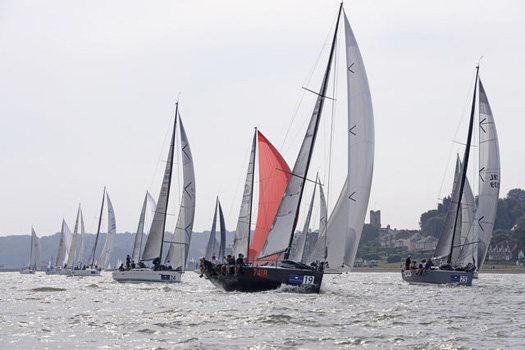
Despite being temporarily in this leeward situation at the front of the fleet after the start of the race round the Isle of Wight on the Friday, Antix soon had herself in a commanding position

Commodore's Cup racers seen through the gap in the Needles Rocks as they edge their way down towards the Needles Fairway Buoy

The steady performer – Quokka sailing better than her rating along the Isle of Wight's southwestern shore during the race round the island.
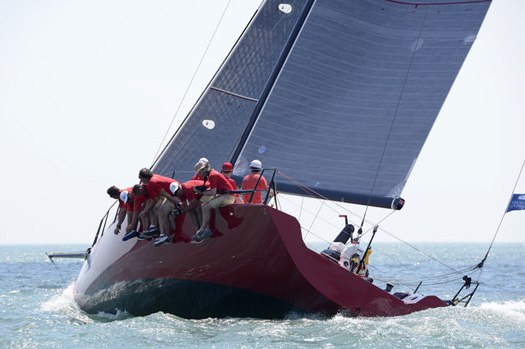
From some angles, she really is quite a weird-looking beast. Catapult developing power down the southwest side of the Isle of Wight
His frustration was heightened by knowing that the experts agreed
that there'd be quite a decent breeze west of the Solent in Christchurch Bay, "yet here they were sending us off around an island with a great big 23 mile gap between places where they could effectively shorten the course".
When I suggested that they might have been able to stop it at the island's south point of St Catherine's, he responded that experience showed that using anything other than a navigation buoy or a floating race mark to shorten a course almost always results in a protest on some grounds.
"After all," he said, "it would be like trying to shorten the Round Ireland race by anchoring a Committee Boat off Rathlin Island". It has to be confessed we both had an unseemly fit of giggles at the very idea of a committee boat hanging on its anchor off Rathlin Island. But that was by way of relieving the remembered tension, for Antix had a bad time down at St Catherine's. Against the foul tide, trying to maintain a very good position she'd built up during the early stages of the race from Cowes, she biffed some rocks, as too did Catapult.
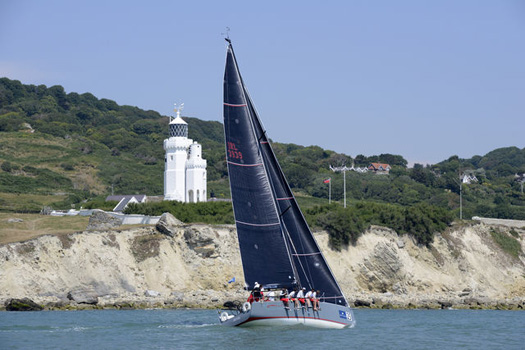
When troubles come, they come not single spies but in battalions.....Antix arrives in fine form and well placed at St Catherine's, only to find a calm and then hit a rock.
It was a very bad moment indeed, yet they hung in still racing, and when the finish was made for a shortened course off Bembridge, Ireland had lost only a few points in her overall lead, she was still well clear. But the troubles were only beginning. A quick liftout showed that Catapult was relatively unscathed. But Antix had serious keel damage, and worse still, a split in the rudder.
With the final double-scoring inshore race coming up in the morning, it was a race against time by James Hynes and the Antix shore team to put right the damage, but after a ten hour session of seriously hard labour through the night, the job was done, and the Irish trio were in fine fettle at the start next morning.

Finishing in style – Catapult on her way to line honours in the final race, and the overall individual championship

The magic moment – Antix and her crew celebrate their win of the final race, and Ireland's victory in the Commodore's Cup
The series concluded with a result from heaven. Ireland didn't merely maintain her already satisfactory points lead over the two French teams next in line. Our team did a horizon job. In an initially good Solent sailing day but with a shortened course as the breeze faded, it was Antix first, Quokka second and Catapult fourth, but with line honours as compensation. It put them 174 points clear. The numbers say it all, for words are inadequate.
The ICRA support team of Barry Rose, Fintan Cairns and Nobby Reilly were besides themselves with excitement, but since then they've calmed down and useful conclusions are being drawn from what they rightly describe as "this magic trip for Irish sailing". For Barry Rose, the abiding memory is of the maturity and sense of focus of the young Irish sailors, and the remarkable compatibility of the three crews.
As for ICRA Commodore Nobby Reilly of Howth, he was impressed by the way that "Anthony and Barry just opened that box of experience, with everyone benefiting. With light and shifting breezes and strong tides, on each boat everyone from front to back was totally involved. This was no easy ride – one mistake and you were bin material".
Fintan Cairns of Dun Laoghaire, who co-founded ICRA with the late Jim Donegan back in 2002, felt there were useful messages to be learnt which might be applied in a larger context. "Keep the management team small in numbers, keep it personal. It's a national success for sure, but we should be wary of anyone trying to "nationalise" it. This was achieved through a sort of sporting private enterprise. Everyone worked very hard indeed. They melded into a marvellous team, and it was an approach which worked very effectively".

Mark Glimcher (right), aka Paddy O'Glimcher, gets the prize of best individual boat for Catapult
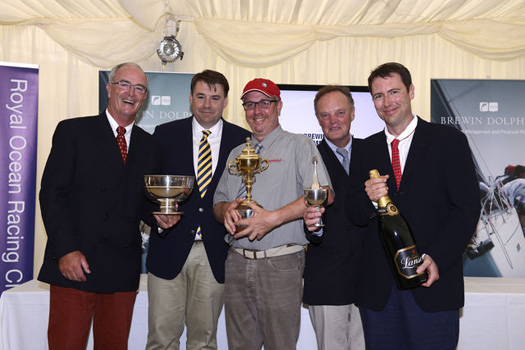
The sweetest moment....the winning team of Anthony O'Leary, Mark Glimcher, Michael Boyd and Niall Dowling with Stephen Ford of Brewin Dolphin
All, of course were lavish in their praise for the Team Captain, whose belief in the do-ability of the project, and his own gallant approach afloat, had brought it all to such a successful conclusion.
The O'Leary Commodore's Cup success is the perfect illustration of the old saying that if you want anything done, then ask a busy man to do it. "So what's next on the agenda?" was the inevitable question asked of Anthony O'Leary as he relaxed in the Royal Cork YC on Wednesday.
"D'you know what" he said, "I haven't a clue. Other than the immediate demands of our business, there's not really a thought in my head. But I've no doubt that some fine morning soon I'll waken up and there'll be an idea about sailing fresh and ready for consideration. And who knows, but it might just be worthy of implementation further down the line".
So we trod delicately around the question of what might happen next with the Commodore's Cup. He happily admitted that he hugely enjoys racing in the Solent, but said that an interesting idea he'd heard was that the Commodore Cup's staging should be rotated between England, France and Ireland. Very diplomatically, he said he'd be particularly interested in racing in it if it was sailed at La Trinite on France's Biscay Coast.

Back to business. Anthony OLeary in thoughtful mode as he addresses the party welcoming the Commodore's Cup back to the Royal Cork YC on Thursday evening. Photo: Bob Bateman
Unsaid from this, but logically following on, is that if the Irish are prepared to go to France, then surely the French and other national teams should be prepared to come to Ireland? It's the great imponderable, and Anthony O'Leary was happy to leave it hanging in the air.
But for now (and this is my personal view), the fact is that Cowes is a sort of Brasilia or Canberra of European sailing, a neutral capital where few people are based, so everyone has to travel to get there. And while the sailing can be exasperating, when it's good it is utterly brilliant.
Then too, we all have to note that the RORC has now entered into partnership with the Royal Corinthian YC in Cowes with its clubhouse near the waterfront. Inevitably, although the RORC has always been associated with some events far from the English Channel in times past, and with a headquarters in London, this new Cowes focus is inescapable, and it will be seen in operation again in eight days time when the RORC Round Britain and Ireland Race gets under way, starting and finishing in Cowes and all crews reporting back to race headquarters there.
As for the Irish cruiser-racing scene, Anthony O'Leary is quite clear in his own mind as to how it should go forward. "I think it's a mistake to incorporate the ICRA Nationals in the Sovereigns Cup in Kinsale, as they're going to do next year" says O'Leary. "The Sovereigns is one of my favourite regattas, but it's a friendly intimate business. While the town may have the infrastructure ashore, the marina is always crowded and I don't see how the kind of fleet they hope to attract will be comfortably accommodated there."
"Then too" he continued, "we already have two major alternating biennial regatta weeks, in Dun Laoghaire and Cork Harbour. It's time to accept that sailing people are seeking to focus on fewer major events, and to give a more compact annual programme their best shot. So let's see how it would work if the ICRA Nationals simply rotated between Volvo Cork Week and the Volvo Dun Laoghaire Regatta."
You might well say this is dynamite, but in the early afternoon peace of the Royal Cork YC, it seemed reasonable enough. It certainly provided enough to think about while driving home along that marvellous highway which the National Roads Authority have obligingly installed the whole way from Carrigaline to Fingal.
But cruise control along the motorway began to look like snooze un-control, so we headed across country for a reviving cup of tea by way of Durrow and Abbeyleix. Durrow was astonishing - the Durrow Scarecrow Festival and All Ireland Scarecrow Championship is in full swing, so give it a look if you're heading southwest over the holiday weekend, it's on until Monday evening when the winner will be declared.
But Abbeyleix was somnolent as only a little Irish town far from the sea can be in the dense heat of late July. No movement at all, except for two plump and jolly men unloading a consignment of shiny new coffins. Very shiny new coffins. You can forget about your fancy modern bio-degradable basketwork coffins for the dear departed of Abbeyleix. When they're planted, they stay planted.
And as for how the ICRA Nationals should shape up in future, well, you heard what the man said.
Ireland Wins Commodores' Cup in Cowes With Style
#rorcbdcc – There are euphoric scenes on the Solent this lunch time as Ireland's three boat team crossed the line in a crucial double points climax to clinch an historic second win of the Commodores' Cup. A lead that held all week was extended this morning when Catapult, Antix and Quokka sailed a top class final race outwitting four British and four French teams for cruiser–racing's top team prize.
Official confirmation of the win came from Ireland's team management, Barry Rose of ICRA, who confirmed the final scores and Ireland's second win of the prestigious yachting trophy.
A jubilant Irish team captain Anthony O'Leary, who had cautioned against any premature celebration – despite Ireland's emphatic 100–point lead – was celebrating with sons Peter, Nicholas and Robert, all members of Ireland's 31–man victorious Irish Cruser Racing Association (ICRA) team. O'Leary's Antix from Royal Cork Yacht Club romped home to win the final race in the same tricky light airs that typified the week long regatta.
Quokka (Michael Boyd and Niall Dowling) of the Royal Irish Yacht Club was second and Catapult fourth (Marc Glimcher) in a final double points race that further extended Ireland's overall winning margin.
The Irish win marks a classy comeback for Ireland to the Royal Ocean Racing Club (RORC) competition after ICRA failed to mount a team to defend the title it first won in 2010.
Ireland's three boat team, comprising Anthony O'Leary's Ker 39 Antix, Marc Glimcher's Ker 40 Catapult and Michael Boyd and Niall Dowling's Grand Soleil 43 Quokka 8, today scored the most comprehensive victory in the 22 year history of the Commodores' Cup. The Irish previously won the Royal Ocean Racing Club's biennial flagship event for national teams with amateur crews in 2010, but were unable to defend in 2012. This year they returned with a vengeance finishing the regatta on 268 points, with an unprecedented lead of 173.5 points. After a disappointing result in yesterday's race around the Isle of Wight, Ireland bounced back strongly in today's double points scoring inshore held on a round the cans course in the central Solent in a light northerly. Impressively the Irish boats claimed three of the top four places on corrected time. Antix put in a particularly powerful performance following the damage she sustained when she hit the rocks close to St Catherine's Point yesterday that bent the aft end of her keel and split the bottom 1ft of her rudder. Lifting the boat out in Cowes yesterday evening, her shore crew worked through the night to ensure she was ready for racing today. "We were determined after yesterday's fiasco to finish stronger, which thankfully we did," said Anthony O'Leary.
{youtube}nQCknLt-aZI{/youtube}
Today Antix led around the weather mark and ultimately claimed her third bullet of this Brewin Dolphin Commodores' Cup. "The amount of work that all 31 people have put in over the last five or six months has been considerable," said O'Leary of the Irish team's victory. "We are very lucky that it all paid off in the end. There is a lot of experience with three boats and it gelled very well and there was great encouragement from one boat to the other. You don't often get a chance to sail as a team - which is the really good thing about this event." Making his debut at the Brewin Dolphin Commodores' Cup in the Irish team was American Marc Glimcher who had brought his 'turboed' Ker 40 Catapult over from the USA. Rating-wise Catapult was the fastest boat at this year's regatta and across the 27 boat fleet finished highest placed individual boat. "What a great week - this is absolutely my number one regatta," enthused Glimcher. "And what an unbelievable team! We had the 'surgeon' - Antix - telling us what to do and the 'clean-up crew' - Quokka - which would always come to the rescue. It was a great group and we sailed the boat better than we ever have. Next time we need to bring a bunch more Americans!" Being the lowest rated boat in the Irish team, Quokka 8, co-skippered by Royal Ocean Racing Club Vice Commodore Michael Boyd and Niall Dowling, had the hardest job among the trio of attaining consistent results. "It has been a very long campaign this," admitted Boyd. "We are newcomers to the event, but we have had fantastic leadership from team captain Anthony O'Leary and we were very fortunate to choose Quokka. It is just very satisfying to have mission accomplished and to do it in a such a comprehensive way today is a huge bonus. At our level as amateurs, the Brewin Dolphin Commodores' Cup is the pinnacle of racing." While the Irish have been the stand out performers this year, the fight remained fierce for the remaining podium positions, where French teams scored a coup. Going into today's final race, France Green was holding second 100 points behind the Irish, with GBR Red third, 15.5 points behind them.
After today's race both lost their hold on the remaining podium positions to France Red - comprising Emmanuel le Men's First 40.7, Pen Koent; Oliver Pesci's Grand Soleil 40, Beelzebuth 3 and Hervé Borgoltz Grand Soleil 44R, Eleuthera - and France Blue comprising Jean Claude Nicoleau's Grand Soleil 43, Codiam; Gilles and Samuel Prietz' A40, Goa, and Bernard Gouy's Ker 39, Inis Mor. This was a particularly spectacular turnaround for France Red jumping from fifth to second after today's race. "Without the Irish it would have been better!" joked Eleuthera's Hervé Borgoltz of his team's performance. "It has been a fantastic race, a fantastic level and a very honest attitude on the water. Two years ago we were third, this year we are second and when we come back in two years we will be first. So slowly, but surely! "What is incredible is how the level is going up - Codiam was second at SPI Ouest France and Inis Mor was yacht of the Year with the RORC last year."
After winning the 2012 event, the performance of GBR's four teams was disappointing with GBR Red the top British team, finishing fourth. Among GBR's 12 boats, Robert Lutener's Ker 40 Cutting Edge was the top performer and second in this regatta. Despite his team's result Lutener remained upbeat: "It was an absolutely top week. Ireland was the top team and they have a top boat and they sail it very very well, but we were close to them and unfortunately the wind let us down yesterday on the offshore.
Otherwise everyone is delighted and has thoroughly enjoyed themselves." GBR Scotland big boat, James McGarry's Swan 45 Eala of Rhu, was also a top performer. "We had a couple of disappointing results, but there were very very difficult sailing conditions," admitted McGarry. "We've been up there consistently inshore and struggled offshore. Otherwise we have had a fantastic week. We have had our moments of glory and we are pretty confident that the boat is going well, just sometimes you don't get the roll of the dice. "The regatta is superb. The level is second to none. You can see why it is billed as the 'premier amateur yacht racing regatta'. Everyone has performed exceptionally; it has just been fantastic fun and a nice atmosphere as well." The prizegiving for the Brewin Dolphin Commodores' Cup was held this evening at the Royal Yacht Squadron.
Team Name Team Points Team Place
Ireland 268 1
France Red 441.52
France Blue 446.5 3
GBR Red 448 4
France Green 456.5 5
Scotland 457 6
GBR White 526 7
GBR Blue 557.5 8
France White 613 9
#rorcbdcc It is now official. Team Ireland have won the 2014 Commodores' Cup!! You may uncork at will.
— Irish Cruiser Racing (@cruiserracingie) July 26, 2014
@AfloatMagazine @royalcork Ireland take Commodores Cup, Catapult sailing under @BaltimoreSC is boat of series!!!!! http://t.co/IjGwBDOjNy
— Peter O Flynn (@Flynner004) July 26, 2014
@cruiserracingie just saw final results - well done to all involved - dominant performance all week. Enjoy the celebrations! #rorcbdcc
— Joe Conway (@Joeconwaydublin) July 26, 2014
Congratulations Team Ireland !! - official results are in and Ireland have won the 2014 Commodores Cup - well... http://t.co/lTV0co0OUn
— Howth Yacht Club (@howthyachtclub) July 26, 2014
Congratulations to #teamireland: Catapult, Antix & Quokka on winning the #commodorescup #smashedit
— Team Scotland CC (@teamscotlandcc) July 26, 2014
Ireland One Race Away from Commodores' Cup Victory in Cowes
#rorcbdcc – The Irish Cruiser Racing Association (ICRA) team in the Brewin Dolphin Commodores' Cup emerged with it's strong overall lead relatively intact after a tough day at sea in the high-scoring round the Isle of Wight race today.
"It's our to lose. We've sailed well through every race, particularly inshore so now we just have have to do what we do best and nothing fancy," said Anthony O'Leary, Ireland team captain. "We're helped that second third and fourth places are so close so that may take the attention off us."
The three boats each made good starts at the Royal Yacht Squadron line and benefitted from a west-going early ebb tide before crossing towards the northern side of the Solent on the westward stage towards Hurst Narrows and onwards to the Needles.
Marc Glimcher's Catapult established an early and strong lead while Quokka 8 chartered by Michael Boyd and Niall Dowling stuck close to team captain Anthony O'Leary on Antix with both placed sixth and fifth on water water. By the halfway point at St. Catherine's lighthouse on the southside of the island, the three held second, third and fourth places on corrected time.
However, the ebb tide proved too strong on the eastern shore and several boats including Antix and Catapult briefly touched bottom while sailing slowy close to the shore trying to avoid the worst of the tide. But the entire fleet came to a half short of Ventnor and a decision was made by the Royal Ocean Racing Club race management team to shorten the course at Bembridge.
"We were quite upset with today's race. Every forecast in Europe predicted a shut-down at mid-day and that's exactly what happened," said Anthony O'Leary. "Still, it was a minor loss of points in the overall context of the series."
A thunderstorm brought fresh breeze and the fleet got going again with Catapult first across the line though this corrected to 17th place on IRC handicap time. Quokka scored best in 13th place while Antix was 22nd; a scoring multiplier of 1.5x was applied to all positions.
In the final analysis, Ireland still has a considerable lead of 94 points with a single race today counting for double points.
Additional report from James Boyd/RORC
Throughout this Brewin Dolphin Commodores' Cup the racing has been blessed with Mediterranean conditions - scorching temperatures and generally light to moderate winds. This has favoured the big boats which have cleaned up in the windward-leewards and Monday's offshore race. But today this all changed.
The Race Committee stuck to the schedule and sent the nine 3-boat teams on a course anti-clockwise around the Isle of Wight. The start was at 09:30 BST from the Royal Yacht Squadron line, and the Blair family's King 40 Cobra in GBR Red and Jamie McGarry's Swan 45 Eala of Rhu in GBR Scotland were called OCS and had to return.
There were two schools of thought among the boats heading west down the Solent and it was the group closer to the mainland shore which prevailed, including the five 'fast boats' - the three Ker 40s, the new A13, Teasing Machine, and Swan 45, Eala of Rhu, over the boats closer to the island shore. American Marc Glimcher's turboed Ker 40 Catapult pulled ahead on the water in the Solent leading around the South West Shingles buoy off the Needles.
The northeasterly breeze held on the southeast side of the island, the boats able to lay St Catherine's but edging closer to the shore as the foul tide began affecting them.
While the rich got richer, in particular Catapult, which was doing a 'horizon job', they rounded St Catherine's Point into no wind and a building adverse tide, forcing boats to rock hop along the shore line or to kedge to prevent themselves drifting backwards. Several boats touched sand or worse, rocks, the worst affected being the star of the Irish team, Anthony O'Leary's Ker 39 Antix, which upon arriving in Cowes tonight has had to be hauled out for repairs.
This park-up allowed the smaller boats to sail in with the breeze causing the form in this year's Brewin Dolphin Commodores' Cup to be upturned with the lowest rated boats taking the lead on corrected time. With the course shortened, finishing at Bembridge Ledge, there wasn't enough track left for the big boats to recover and the 'fast five' became the 'last five' on corrected with the smallest boats topping the results.
The star performer was David Aisher's J/109 Yeoman of Wight. Having been one of the southerly losers coming down the Solent, and then seeing the leaders disappear on the leg to St Catherine's, as Aisher put it: "When we went around the corner at St Catherine's, it was 'oh, hello!' - everyone had parked up. Then it was a case of finding the gusts. We clouted a rock, but not badly because we were only doing 0.5 knots through the water, but Antix hit the bricks hard."
In the subsequent battle of the small boats, Yeoman was fighting with GBR Blue team mate and sistership Robert Stiles' Diamond Jem and Iain Kirkpatrick's X-37 Fatjax for the overall lead. Aisher continued: "In the last three miles they took a tack out too far, while we saw the wind kicking in from the left. Thanks to that we gained maybe 30 minutes on them. Considering we only won by two minutes, it made all the difference."
French boats came out well today with seven in the top 10. Benoit D'Halluin's A35, Dunkerque Plaisance-Gill Racing Team, in France White, finished third behind Emmanuel le Men's First 40.7 Pen Koent in France Red.
"This time it was a race for the small boats after the difficult round the cans and windward-leeward races," said a delighted D'Halluin. "We did well at St Catherine's where all the boats stopped - we had very good speed for us and caught up with all the big boats. We saw two boats hitting the rocks. We were okay but there was a lot of tacking. A lot of boats anchored, but we kept going. After that we had less than 5 knots from the northeast and it was difficult to be in the right place. We didn't do very well."
It is rare to see a Farr 30 One Design competing under IRC, but Eric Basset's Motivé, the smallest boat in the regatta and racing in France Green, was one of the boats that had pulled into the lead under IRC during the park-up. They ended the race in ninth place, their best result of the regatta.
"Going around the island was a fantastic moment," said Anglo-French crewman, Jean-Charles Scale, who was sailing this course for the first time, despite heralding originally from Fareham. "Conditions were pretty good for us during the first part of the race. Then after the Needles it was difficult because we are the smallest boat and we were tight reaching and we were not fast enough. But then all the boats parked up and stalled and we got to within about half a mile of the big boats."
Once again on this occasion it paid not to kedge and Scale said they managed to keep moving, just, while other boats around them chose to anchor. "We went in close to the beach after St Catherine's - it was pretty dodgy and four or five boats touched but fortunately we managed to avoid that."
After that he admitted it was difficult to know whether to go inshore or offshore, but they had chosen the former. Ultimately they ended up finishing in ninth place. Their result, and that of Gilles Caminade's A35R Chenapan3, has caused them to relieve GBR Red of second place overall in the team rankings.
Despite a poor result today - their highest placed finishers being Michael Boyd and Niall Dowling's Grand Soleil 43, Quokka 8, coming home a lowly 13th, Ireland has retained the majority of their lead and goes into tomorrow's double points scoring final race with a comfortable 94.5 margin over the French. Even though nothing is certain in this regatta, if all three of the Irish boats sail their worst result to date in this event, they will still claim the Brewin Dolphin Commodores' Cup by a 10 points.
Team Name Team Points Team Place
Ireland 254 1
France Green 348.5 2
GBR Red 364 3
France Blue 368.5 4
France Red 371.5 5
Scotland 387 6
GBR White 422 7
GBR Blue 441.5 8
France White 445 9
#icra - What should have been a long inshore race along The Solent in the Commodores Cup today turned into a waiting-game with no reward at the end in the Brewin Dolphin Commodores' Cup at Cowes as racing was abandoned for the day.
Ireland remains the event leader after three races including the high-scoring offshore event that finished in the early hours of Tuesday morning.
After starting this morning one hour earlier than planned, all three Team Ireland boats had a good start to the race that enjoyed a light north-westerly breeze off the Peel Bank. But the ebb tide was building and when the wind died, only seven boats had managed to break out of the notorious tidal stream.
Marc Glimcher's Catapult was second on the water followed by Anthony O'Leary's Antix in fifth and Michael Boyd and Niall Dowlings' Quokka 8 in seventh.
As the leaders reached Hayling Bay and started the windward-leeward section of the course, the bulk of the fleet were still trapped in The Solent. The Race Committee then abandoned the race on fairness grounds and opted to set a straight-forward windward-leeward course.
Once underway, barely had this race completed it's first of two laps than the wind shifted 100 degrees and then died leading to a second abadonment. After waiting to see if the breeze returned, the fleet began motoring back to Cowes some 12 miles distant in the hope of picking up more breeze in The Solent but to no avail.
The crews are expected back in West Cowes by 1800hrs and the Royal Ocean Racing Club is expected to announce changes to the remainder of the week which just has to complete one more race to qualify as a series.
Weather forecasts between now and Saturday do not offer much prospect of change and the normally reliable sea breeze has been hampered by the stationery high pressure system over the region.
Additional reporting by RORC
Day four of the Royal Ocean Racing Club's Brewin Dolphin Commodores' Cup was one Principal Race Officer Stuart Childerley and his team would prefer to forget.
With the best wind forecast for early morning, the 27 boats in nine teams started an hour early from a line off Peel Bank. The plan was for them to sail north to the North Ryde Middle mark and then east out of the Solent and into Hayling Bay onto a windward-leeward course.
Childerley recounted: "The boats started reaching out towards the Forts and there were a few big holes there and then six of the boats got to St Helens [mark in Hayling Bay]. Meanwhile the rest of the fleet was being affected badly by big holes in the wind, so we had a situation where probably over half of the fleet wouldn't have finished within the time limit. So we had to abandon that one."
There followed a long wait for the boats in the Solent to reach the new start area in Hayling Bay before a second attempt at race four of the series could be made - this time a windward-leeward in an offshore northeasterly breeze of 6-7 knots. Unfortunately as the boats were approaching the leeward mark the wind shifted hard right, by more than 90°, into the south. The race committee spotted this quickly enough to lay a new weather mark, but after the top six boats had rounded it the breeze dropped away to nothing and the fleet came to a standstill. This race was abandoned too.
"It was just pretty unsatisfactory," said Childerley. "We have had one race in this series when there was a bit of a shut down. I am trying at all costs to avoid that again."
Unfortunately conditions for the next two days are not looking much better.
Mike Broughton, meteorologist for the Irish team, current leader in the Brewin Dolphin Commodores' Cup, explains that there is currently an area of high pressure centred over Norway, bringing Mediterranean conditions to the UK, but making conditions difficult for yachting. "The northeasterly wind has to come all the way across 150 miles of land to get to us and so it is very patchy and shifty. Then you have a sea breeze that is trying to make it in and is fighting it. Today we had a full on fight with no one winning. It is difficult, but it is what it is."
Broughton says that tomorrow it could be even worse with a trough passing over, bringing rain showers.
RORC Vice Commodore Michael Boyd, who is the co-charterer with Niall Dowling of the Irish team's Grand Soleil 43 Quokka 8, commented: "It was an impossibly challenging day for the PRO and I don't envy his job. In retrospect maybe he could have shortened the courses, but that is all 20-20 hindsight."
Boyd added that he was happy with the position the Irish boats were in when the two attempts at race four were abandoned today. "We would have advanced a few more points, but the races weren't fair. In the first there were four separate fleets.
"The forecasts we have seen for the next three days is for a declining wind. So I think we just have to sail in what God gives us and be patient. This is a sport and you just have to stay focussed and alert."
Jean Philippe Cau, sailing on Hervé Borgoltz' Grand Soleil 44R, Eleuthera, in the France Red team, said that in the first attempt at race four they had been very pleased with their performance, matching Anthony O'Leary's Ker 39, Antix. He observed that when that race was abandoned there had been a gap of more than a mile between the front runners and those astern.
"And in the second race we did well also," Cau continued. "We were in the match with the first group of boats including Quokka, and at the weather buoy when the wind disappeared it was very difficult to pass the boats. We were not happy with Quokka [overlapped on the outside of them at the second weather mark] so we had a little fight with them! There were red flags going up!"
In addition to sailing, Cau has also been responsible for putting together the giant French four team entry in this year's event. He says he is pleased with his country's performance, particularly France Green, which includes Eric De Turkheim's radical new A13 Teasing Machine and Eric Basset's modified Farr 30, Motivé. "If the Farr 30 is able to do reasonably well in the next races, which is especially possible in light winds, I think there is really the possibility to do well. My prognostic is that we will have two teams on the podium."
Tomorrow the race management team will once again aim to get racing underway at 10:00 BST. Childerley concludes: "If we can get at least one in tomorrow, Saturday is looking more promising and, with a couple of jiggles around, we'll get the series in. But most important is that I want to give people really good racing. That is the key."
Team Name Team Points Team Place
Ireland 126 1
France Green 152 2
France Blue 172 3
GBR Red 172.5 4
France Red 197.5 5
Scotland 201.5 6
GBR White 210.5 7
France White 216.5 8
GBR Blue 252.5 9
Ireland Take Early Lead After Commodores' Cup Day One
#CommodoresCup - Ireland lie in first place after a solid first day of racing in the Brewin Dolphin Commodores' Cup at the Royal Ocean Racing Club in Cowes.
The Irish contingent of 31 sailors were scored at 41 points, putting them 19 ahead of their closest rivals in the British 'red' team, while the French 'blue' tram trails in third position on 77.
And as the provisional race results show, it was Antix - Anthony O'Leary's Easter Challenge-winning Ker 39 - that stole the show today, crossing the line first in the opening duo of inshore races on the Solent.
But there's still a full week of racing to go, including the lengthy overnight offshore race that kicks off tomorrow (Monday 21 July).
Ireland has not competed in the Brewin Dolphin Commodores' Cup since winning the event in 2010, but today on the Solent the defending champions once removed got off to a strong start in the Royal Ocean Racing Club's biennial flagship event for national teams with amateur crews.
The Emerald Isle has one of the strongest teams competing in Cowes this week, led, as in 2010, by Anthony O'Leary and the Ker 39, Antix, recent winner of the RORC's IRC National Championship. Today's two inshore races were held in light conditions in the southeastern Solent and Antix won both. With additional consistent performances by her Irish team mates, American Marc Glimcher's turboed Ker 40, Catapult, and Michael Boyd and Niall Dowling's Grand Soleil 43, Quokka 8, Ireland now leads the 2014 Brewin Dolphin Commodores' Cup with a 19 point advantage over GBR Red.
"On Christmas morning you'd say 'yes please',"said Anthony O'Leary of Antix's performance. "We got away cleanly in the two starts. We had a nice position on the line and were able to rumble on without interference, which meant we could make our own decisions. The second race was a bit all over the place. But at the moment it is just shadow boxing - the offshore is what is really important." The event's 24-36 hour long offshore race sets sail tomorrow.
Today's first race was a windward-leeward, held in a light 6-8 knot westerly with the start line set off Osborne Bay. The second was around the cans but took place as the southwesterly sea breeze was attempting to fill in over the light gradient. This caused the wind to shut down mid-way through as the fleet were attempting to round a mark in Osborne Bay. The leaders slipped through but the fleet ended up split in two with half a mile of separation.
"The fleet concertinaed down in Osborne Bay, but we managed to pick the right lane to the next buoy which dug us out of that," continued O'Leary.
Equally consistent, coming home second and exactly 30 seconds behind Antix in both races, was the Scottish team's Swan 45, Eala of Rhu. "It was a very good day for the team," said owner James McGarry, for whom this is his first Brewin Dolphin Commodores' Cup.
Eala of Rhu is the longest boat competing and her waterline length paid particularly on the beats in today's flat water races. "We need to get off the line and into clear air to get trucking," said McGarry. "Tactically the tide did a lot for us as well, keeping on the right side of the course and keeping out of the deep water."
As to the tricky Osborne Bay mark rounding, McGarry described it: "The wind went inside out, it died off but we were lucky enough to plug our way around the mark, get across what should have been the reach and then fight our way uptide to the finish. It could have been completely the opposite."
After two inshore races, Scotland is fourth of the nine teams. Roderick Stuart and Bill Ram's Corby 37, Aurora, struggled today, but as McGarry observed: "They get pinned into a much larger group of boats and have a seriously hard job of trying to fight their way out of it. They are sailing the boat well."
Lying second in the overall team results is GBR Red, where Seb and Mike Blair's King 40, Cobra, was star performer today, posting a third in both races.
Helmsman Chris Walmsley said of their races: "In the first, we wanted to be left off the line which we were and then take the first opportunity to tack back up the middle. We felt the middle was where the best breeze was all day. In the second, the sea breeze was fighting to come in the whole time and it never quite reached us until literally the end of the last leg. We were on an A-sail reach heading into Osborne Bay and it turned into a beat as we got back into the older, left-over breeze.
"Generally we are very pleased. We are about where we expected to be in the fleet with other boats."
Leading overall after today's first race was France Green, the team comprising the eclectic mix of Gilles Caminade's A35R, Chenapan 3, Eric Basset's Farr 30, Motivé, - the shortest boat competing - and Eric De Turkheim's radical new Archambault A13, Teasing Machine.
Teasing Machine is 43ft long, weighs more and rates lower than a Ker 40, but has a powerful beamy hull shape complete with a VO70/IMOCA 60 style chamfer running as her deck edge. Unfortunately an error in the second race, that caused her to get caught in a wind hole off the island shore in the second part of the opening beat, caused her to finish last.
Tactician on board is Laurent Pagès, part of Franck Cammas' Volvo Ocean Race winning Groupama team, who admitted: "We were thinking of continuing southwest into the left shift and as it was pretty light at that stage we hoped to get out of the tide. But actually it was the wrong move because we got into a very soft spot and in the meantime the breeze shifted pretty hard into the right. In a very short time it was a very heavy penalty."
Owner Eric De Turkheim was more philosophical: "There is a long way to go. We are pretty happy with the boat, as it was only launched three weeks ago. Today was tough, but I hope we will get better tomorrow."
The course for tomorrow's offshore race will be announced this evening.
2014 Brewin Dolphin Commodores' Cup - Sunday 20th July
2014 Brewin Dolphin Commodores' Cup
Day 1, Sunday 20 July
Team Name Team Points Place
Ireland 41 1
GBR Red 60 2
France Blue 77 3
Scotland 81.5 4
GBR White 83 5
France Green 87 6
France Red 100 7
GBR Blue 105 8
France White 121.5 9
Additional reporting from Barry Rose of ICRA:
Light winds on The Solent presented tricky conditions for the 27-boat fleet in the Brewin Dolphin Commodores' Cup today that saw Irish boats to the fore.
Team captain Anthony O'Leary on Antix won both short inshore courses, cementing his record this year that included the overall British title here.
Marc Glimcher's Catapult delivered a highly consistent day with a seventh and fourth place while Michael Boyd and Niall Dowlings' Quokka 8 overcame a 23rd place in race one after a difficult start and were fifth in the afternoon.
Race one started in a light nor'westerly breeze but a big shift caught the boats that has headed inshore towards Osborne Bay then favouring the boats on the right. In the second race, Osborne again became a fraught zone when half the fleet were becalmed there.
The defending champions from 2012 are Britain Red who are currently in second overall while the France Green team are also very strong in third overall. The sole Scottish team hold a close fourth place, boosted by Eala Of Rhu that placed second behind Antix in both races.
"Team Ireland has made a strong start to what is a very long series so we must be cautious at this early stage," commented Barry Rose of the Irish Cruiser Racing Association support team. "Tomorrow's offshore race counts for bonus points that our boats in particular will relish. However, the forecast is for the winds to become light so it will be an especially testing race for every team."
The fleet will start the offshore race at 9.25am on Monday morning and won't return for at least 24 hours. Race management teams from the Royal Ocean Racing Club will set the course so that it could be shortened if the wind becomes too light to race though the forecast is for wind today at least.
Ireland won the Commodores' Cup for the first time in 2010 and has returned to Cowes with a fresh challenge for 2014 and is supported by the Irish Cruiser Racing Association (ICRA).
#commodorescup – Having fielded just one team for the last event in 2012, France is back with a vengeance for the Royal Ocean Racing Club's Brewin Dolphin Commodores' Cup this July.
Since Géry Trentesaux's French team stole victory from the powerful Irish in 2006, France has never finished better than third, but this year they intend to put this right. And to give some idea of what the British and Irish teams will be potentially up against you don't have to look much further than the results from last year's Rolex Fastnet Race, where an incredible 12 of the top 14 finishers were our cousins across 'La Manche'.
To make the point, France is equalling the British line-up, bringing four teams to Cowes over 19-26th July for this year's Brewin Dolphin Commodores' Cup.
Jean-Philippe Cau, who raced the last Brewin Dolphin Commodores' Cup aboard Eleuthera and put together the selection panel for this year's French team, shares the French view of the event and why there is such a substantial entry: "I love the Commodores' Cup. I think it is one of the best regattas. The format is great - there are a lot of inshores, and the offshore are not too long, just 36 hours. Plus now you also have the Round the Isle of Wight Race which is a very, very good race. So it is a good mix of sailing. We also really enjoy racing in the Solent because conditions are never the same there."
The line-up of the four French teams is:
France Red
Hervé Borgoltz, Grand Soleil 44R, ELEUTHERA
Olivier Pesci, Grand Soleil 40, BEELZEBUTH
Emmanuel Le Men, First 40.7, PEN KOENT
France White
François Lognoné, J/122, NUTMEG
Philippe Baetz, Grand Soleil 37, MUSIX
Benoit D'Halluin, A35, DUNKERQUE PLAISANCE
France Blue
Bernard Gouy, Ker 39, INIS MOR
Jean-Claude Nicoleau, Grand Soleil 43, CODIAM
Gilles and Samuel Prietz, A40RC, VITARIS-GOA.
France Green
Eric De Turckheim, A13, TEASING MACHINE
Gilles Caminade, A35R, CHENAPAN 3
Eric Basset, Farr 30, MOTIVE
Among these 12 are many repeat customers, including all three boats that competed in 2012 - Eleuthera, Beelzebuth 3 and Nutmeg IV. Of these it will be the third consecutive Brewin Dolphin Commodores' Cup for François Lognoné's J/122 Nutmeg, while Beelzebuth won its class at the RORC's IRC National Championship last year.
One of the most faithful French boats to the Brewin Dolphin Commodores' Cup is Jean-Claude Nicoleau's Grand Soleil 43 Codiam, which competed in 2006, 2008 and 2010. Also back, after they took part in 2010, is regular RORC competitor Bernard Gouy and his Ker 39, Inis Mor, which ended the 2013 season fifth overall in the RORC Season's Points Championship.
Emmanuel Le Men's First 40.7, Pen Koent, raced in France Red in 2008 and has been performing well this year. Now fitted with a new carbon fibre mast, she was matching the performance of the A35s for most of SPI Ouest.
According to Jean-Philippe Cau, while France has strength in numbers, they also have depth across their four teams. Disappointed by the French team selection process and subsequent performance in the 2012 Brewin Dolphin Commodores' Cup, this time Cau put together the selection committee for the French team comprising personnel from the Fédération Française de Voile, the Union Nationale pour la Course au Large and PropIRC, the French IRC owners association of which he is President. Last autumn he began to drum up interest in the event among French IRC owners.
Whereas in 2012 there was a very stringent selection process that left potential teams hanging until as late as mid-June to find out if they were competing, this time Cau says they are being much more inclusive, or more of a 'qualification' than a 'selection' as he puts it. Boats wanting to represent France had to compete in 10 races this spring, including for example six at SPI Ouest France. However Cau is keen to point out that the French teams announced haven't been arranged according to which teams performed the best in these 10 races. In those events for example many were racing with more pro sailors on board than are permitted for the Brewin Dolphin Commodores' Cup.
In addition to the boats returning, the French team also features a number of new boats, including three Archambault models, the A40RC Vitaris-Goa of Gilles and Samuel Prietz, plus two others racing in France Green - Chenapan 3 is the new A35R owned by Gilles Caminade, while Teasing Machine is the manufacturer's latest A13 model owned by Eric De Turckheim.
Cau rates the new boats highly: "The new A35 is a very, very good boat. For the time being it is the best IRC boat in France. But they haven't had much time to sail her." Teasing Machine is only being launched this month. Her pro on board will be America's Cup sailor, Laurent Pages, who was also part of Franck Cammas' winning Volvo Ocean Race crew.
A Farr 30 also features in France Green. Cau explains: "In the Mediterranean there are two or three Farr 30s competing in IRC Two and they regularly win races. However they have a modified mainsail and also have an asymmetric spinnaker." Motive has been modified similarly, her skipper Eric Basset, being is an old hand from the Tour de France a la Voile.
Expect the strongest French performance this year since 2006.
Third Boat Sought for Ireland to Contest 2014 Commodore's Cup
#commodore'scup – Ireland is set to contest the 2014 Commodore's Cup with two of three boats required already slated for the biennial event which is being held in Cowes, Isle of Wight between 17-25 July 2014. Sailing officials from the Irish Cruiser Racer Association (ICRA) remain tight lipped about team composition but it is understood a third boat has been identified and negotations to form the squad are ongoing.
An ICRA press release says the Irish Team have two very competitive boats, one Irish and one from the U.S. Both have top Irish sailors as part of their crew.
In 2010, Ireland won the event but disappointingly in 2012, in the teeth of recession, Ireland did not defend the Commodore's Cup title after weeks of doubt about Ireland's ability to put a competitive three boat team together.
Now it looks like Former Irish Cruiser Racer Commodore Barry Rose will make good on his 2012 promise to 'return with a credible team for the 2014 event'.
Rose reported to a September executive meeting of the sailing body that two 'strong boats' are interested and a third is being sought for an Irish team.
ICRA now say a third slot is still available and is an opportunity for a competitive boat or Irish team.
The executive also discussed fielding a corinthian team and the possibility of a second Irish team remains a possibility.
In the UK, the RYA is planning for next season's premier sailing event, the Brewin Dolphin Commodores' Cup
The biennial event, organised by the Royal Ocean Racing Club, is one of the most prestigious events on the international yachting calendar culminating in a tough mix of inshore and offshore racing across a tense seven-day racing programme on the testing waters of the Solent.
With RYA GBR Red having won the event in 2012, the pressure is back on for a successful defence of the trophy. In order for owners to be able to plan and prepare their boats and teams, the RYA is looking to invite either owners or their representatives to a meeting in London or Southampton in late November to inform them of the selection process and to discuss training weekends and qualification events in the build-up to selecting the teams to represent the RYA.
The Commodores' Cup, which started in 1992, is an international three-boat team event using the IRC Rating system and is open to boats rated between 1.020 and 1.230, with only one boat rated above 1.150.
Janet Grosvenor, Chair of the RYA Offshore Racing Group, said: "The Brewin Dolphin Commodores' Cup next year is coming up fast and we need to make sure we have the buy-in of owners and sailors at an early stage so that we can help support them in their preparations both for the trials as well as for the event itself. Having spoken to RORC it looks like another high quality year with regards to entries and we are excited about the prospects of the potential RYA teams for next year."
"The RYA has in place a Selection Committee who will be introduced at the meeting. They have the challenging job of working with the teams over the winter and spring and making the final decision on which boats are finally selected to represent the RYA."
The RYA is urging interested parties to register their interest in the BDCC Owners Meeting and the opportunity to represent RYA Team GBR at the 2014 regatta as soon as possible.
For more information on the Brewin Dolphin Commodores' Cup meeting or if you're interested in finding out more then please contact [email protected], RYA Technical and Racing Services Manager.

































